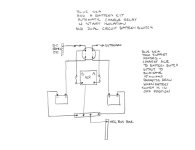yukonjbishop
New member
- Joined
- Apr 15, 2012
- Messages
- 13
- Reaction score
- 0
- C Dory Year
- 2005
- C Dory Model
- 22 Cruiser
- Vessel Name
- Silvertip
The wiring in my C-Dory needs to be re-worked. Attached is a photo showing the current wiring. It is a 2 bank battery system - both Group 24 deep cycle. Currently all connections are by ring terminal directly to the battery terminals. The house battery terminals are a congested mess.
Also attached is a photo of my proposed rewiring - I'm new to the wiring game - before I proceed I'd like some feedback hopefully to confirm the proposed wiring plan is good to go OR to identify problems with the plan or changes/improvements that should be made.
You'll see I plan to change my battery switch from the traditional Off/1/2/Both to a Dual Circuit Blue Sea and add an Automatic Charging Relay (ACR) with Start Isolator (the Blue Sea Add-A-Battery Kit). I was concerned about the ACR's parasitic draw (15ma) when the battery switch is in the "Off" position and spoke to tech support at Blue Sea today… they advised me to connect the ACR to the output posts on the battery switch which will eliminate the ACR parasitic draw when in the off position. I have attached a photo showing the Add-A-Battery wiring diagram as recommended by Blue Sea tech support.
Two final questions:
1. Am I correct to connect the Guest AC charger wires directly to the terminals for each battery?
2. I have 2 bilge pumps - one at the bulkhead which is wired into the switch panel at the helm - the switch has an off/auto/manual position. The second (the aft bilge) is in the well at the drain plug. I was thinking the aft bilge should be wired directly to the terminals on the house battery to bypass the battery switch.
Comments, suggestions. Thanks. Preparing the boat for a several week trip in SE Alaska… leaving in 3 1/2 weeks.



Also attached is a photo of my proposed rewiring - I'm new to the wiring game - before I proceed I'd like some feedback hopefully to confirm the proposed wiring plan is good to go OR to identify problems with the plan or changes/improvements that should be made.
You'll see I plan to change my battery switch from the traditional Off/1/2/Both to a Dual Circuit Blue Sea and add an Automatic Charging Relay (ACR) with Start Isolator (the Blue Sea Add-A-Battery Kit). I was concerned about the ACR's parasitic draw (15ma) when the battery switch is in the "Off" position and spoke to tech support at Blue Sea today… they advised me to connect the ACR to the output posts on the battery switch which will eliminate the ACR parasitic draw when in the off position. I have attached a photo showing the Add-A-Battery wiring diagram as recommended by Blue Sea tech support.
Two final questions:
1. Am I correct to connect the Guest AC charger wires directly to the terminals for each battery?
2. I have 2 bilge pumps - one at the bulkhead which is wired into the switch panel at the helm - the switch has an off/auto/manual position. The second (the aft bilge) is in the well at the drain plug. I was thinking the aft bilge should be wired directly to the terminals on the house battery to bypass the battery switch.
Comments, suggestions. Thanks. Preparing the boat for a several week trip in SE Alaska… leaving in 3 1/2 weeks.



